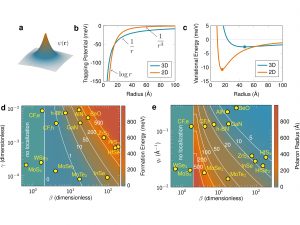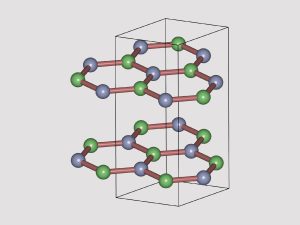2D materials have gained widespread attention in both the scientific community and industry. To tap into the potential of these materials, our team at the University of Macau (UM) and the University of Texas at Austin (UT Austin) has proposed a new framework to understand how polarons form in 2D crystals and why they are so different in 2D and 3D structures, seeking to advance novel 2D applications in different fields.
Interactions between Electrons and Phonons May Deform Materials
This research project is a collaboration between me and Prof Feliciano Giustino in the Department of Physics at UT Austin. The concept of polarons was introduced in the 1930s by the Soviet physicist Lev D. Landau, who won the Nobel Prize in Physics in 1962. In the 1950s, polarons were observed experimentally for the first time. Over the decades, discoveries in this field have significantly contributed to advancements in photocatalysts, light-emitting diodes, solar energy harvesting, and beyond.
To comprehend our theoretical framework, it is necessary to understand what a polaron is. Imagine yourself as an electron, attempting to enter a crystal lattice comprising several tens of thousands of atoms. As you move freely around, you quickly realise that the atoms surrounding you are shaking gently, thereby generating some vibrational patterns like ripples, namely phonons.
Soon after, you start to interact with these phonons, a phenomenon known as electron-phonon interaction. When these interactions are strong enough, you find yourself becoming much heavier because you are now accompanied by a cloud of phonons that moves together with you. This not only makes you and the phonon cloud look like a massive particle, but also gives you the ability to deform the surrounding parts of the crystal structure and alter its physical properties. The intense interaction between the electron and the vibrations makes the electron behave differently than normal free electrons in a perfect crystal, which is called an electron polaron – a type of polarons.
Polarons may be understood as a group of interacting particles that can change the properties of their host materials, rather than being a particular fundamental particle. They function much like when you walk inside a building, your friends surround and walk with you, and then your close interactions provide a collective power able to deform the building’s structure.
In some cases, a polaron can trap itself, or become ‘self-trapped’, somewhere within the material’s structure. A trapped polaron can alter material properties, including an ability to modify the conductivities of electricity and heat, renormalise band gaps, and become more profound and stable than band electrons.
A New Framework for Studying Polarons
Nearly a century since polarons were first studied, it remains challenging to describe and predict the behaviour of polarons, largely because early polaron theories were developed based on relatively simple mathematical models. In fact, studying polarons and the related deformation of materials can involve describing at least ten thousand atoms and electrons within a material, a task that even certain modern supercomputers would find difficult.
To fill this theoretical gap, we have developed a general theoretical framework that enables the computation of electronic and structural properties related to electron-phonon interactions in 2D and 3D materials. We have also clarified the analytical form, essentially a mathematical expression, of the interactions between electrons and phonons separated by long distances.
Based on this newly developed framework, we have proposed a computational model for simulating polarons in 2D materials, and a mathematical model for predicting the ground state energy (the lowest energy state that a polaron can occupy in materials) of self-trapped polarons in such materials.
Observing Polarons in White Graphene
Our research focuses on 2D single-layer materials. They are basically flat structures that are usually only one atom thick, unlike 3D materials with which most people are familiar. In recent years, we have witnessed significant advancements in polaron research in 3D materials, but much remains to be uncovered about 2D materials.
Using our new framework, we have for the first time observed a type of Fröhlich hole polarons (a type of polarons with a positively charged hole at its core) in white graphene, a 2D material known scientifically as hexagonal boron nitride (h-BN), and have determined its real-space structure. It has a repeating geometric pattern resembling a honeycomb, as well as unique properties that make it a suitable material for cosmetics, lubrication for satellites and other products.
Computer Simulation of 2D Materials
Studying polarons in 2D materials often require computer simulation of these materials. Our new computational method can overcome a problem known as the Coulomb divergence. This allows us to accurately describe the geometric details of self-trapped polarons in different 2D materials, and precisely calculate their radius and ground state energy.
Furthermore, we have proposed a mathematical model that allows us to calculate whether and how an electron can form a self-trapped polaron in 2D material by considering only three factors, namely the effective mass of the electron, the effective thickness of the 2D material, and the ionic dielectric screening of such a material.
Using Impurities to Develop Novel Materials
In 2D materials, defects and impurities can significantly affect the behaviour of polarons and can sometimes promote the formation and self-trapping of polarons. We believe that our framework and models may enable physicists to control more precisely the stability, mobility, and properties of polarons in materials, so that they can alter the materials more precisely, by leveraging defects already in the materials, or intentionally introducing impurities to the materials. This will help them more efficiently develop 2D materials with tailored properties.
Simulating 100,000 Atoms for Validation
We validated this discovery with a simulation of up to 100,000 atoms. This task used thousands of CPU cores of the Lonestar 6 supercomputer at UT Austin. Essential computing power was also provided for this research by the LvLiang Cloud Computing Center in China and the Texas Advanced Computing Center at UT Austin. Our related research article, titled ‘Polarons in Two-dimensional Atomic Crystals’, has been published in Nature Physics.
As the quest for smaller and faster devices continues, polarons in 2D materials have emerged as a promising avenue with endless possibilities. That is what propelled us to conduct this research, and what continues to motivate us to develop new theoretical and computational methods.
Author:
Sio Weng Hong is a UM Macao Fellow in the Institute of Applied Physics and Materials Engineering at UM. He holds a PhD in computational materials science from the University of Oxford. His research interests include polarons and electron-phonon interactions, computational methods for materials science, condensed matter and electronic structure theory, as well as 2D materials.
Text & Photo / Sio Weng Hong
Chinese Translation / Davis Ip
Source: UMagazine ISSUE 27



